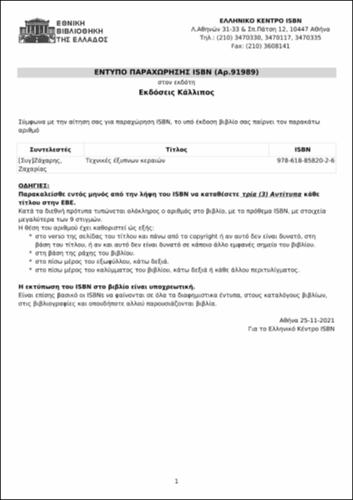Adobe PDF
(1.25 MB)
Brochure
Download
| Title Details: | |
|
Smart Antenna Techniques |
|
| Authors: |
Zaharis, Zaharias |
| Subject: | ENGINEERING AND TECHNOLOGY > TECHNOLOGICAL SCIENCES AND ENGINEERING > TELECOMMUNICATIONS ENGINEERING AND TECHNOLOGY ENGINEERING AND TECHNOLOGY > TECHNOLOGICAL SCIENCES AND ENGINEERING > TELECOMMUNICATIONS ENGINEERING AND TECHNOLOGY > RADIOCOMMUNICATIONS ENGINEERING AND TECHNOLOGY > TECHNOLOGICAL SCIENCES AND ENGINEERING > TELECOMMUNICATIONS ENGINEERING AND TECHNOLOGY > MICROWAVE LINKS ENGINEERING AND TECHNOLOGY > TECHNOLOGICAL SCIENCES AND ENGINEERING > TELECOMMUNICATIONS ENGINEERING AND TECHNOLOGY > DIGITAL COMMUNICATIONS ENGINEERING AND TECHNOLOGY > TECHNOLOGICAL SCIENCES AND ENGINEERING > TELECOMMUNICATIONS ENGINEERING AND TECHNOLOGY > MOBILE COMMUNICATION NETWORKS ENGINEERING AND TECHNOLOGY > TECHNOLOGICAL SCIENCES AND ENGINEERING > TELECOMMUNICATIONS ENGINEERING AND TECHNOLOGY > BROADBAND NETWORKS |
| Keywords: |
Smart antennas
Phased antenna arrays Direction-of-arrival estimation techniques 5G wireless communications 5G communications systems Beamforming Digital beamforming Antenna array beamforming |
| Description: | |
| Abstract: |
This book analyzes in depth a class of techniques applied to the so-called "smart antennas". Smart antennas are a class of antenna arrays, which have the ability to steer their radiation beam toward a desired user, thus enhancing the signal reception from this user, while suppressing the reception of any unwanted signals, which can be transmitted at the same time from other directions and therefore could interfere with the reception of the desired signal. This means that smart antennas have the ability to produce a dynamic radiation pattern, i.e., a radiation pattern constantly changing in real time, so as to optimize the reception of the desired signal and suppress all interference signals. The difficulty in implementing such antennas lies in the fact that users, who are served by modern wireless communication networks (such as 5G or beyond 5G wireless networks), are constantly moving in a real environment, while the need for broadband connection is growing. Therefore, a base station antenna, which receives a number of signals from several users at the same time, must properly shape its radiation pattern, so that at any given moment the main lobe is steered toward the desired signal, while at the same time radiation nulls are placed toward respective directions of arrival of unwanted signals. This process is constantly repeated in real time as users move within the geographical service area. Τhis book provides (1) the mathematical formulation and analysis of the most popular beamforming techniques applied to smart antenna arrays according to the requirements in force, and (2) the mathematical formulation and analysis of the most popular direction-of-arrival estimation techniques applied to signals received by a smart antenna array.
|
| Linguistic Editors: |
Oxenkioun, Eleni Elissavet |
| Technical Editors: |
Oxenkioun, Eleni Elissavet |
| Graphic Editors: |
Liomas, Ioannis |
| Type: |
Undergraduate textbook |
| Creation Date: | 17-03-2022 |
| Item Details: | |
| ISBN |
978-618-85820-2-6 |
| License: |
Attribution - NonCommercial - ShareAlike 4.0 International (CC BY-NC-SA 4.0) |
| Handle | http://hdl.handle.net/11419/8038 |
| Bibliographic Reference: | Zaharis, Z. (2022). Smart Antenna Techniques [Undergraduate textbook]. Kallipos, Open Academic Editions. https://hdl.handle.net/11419/8038 |
| Language: |
Greek |
| Publication Origin: |
Kallipos, Open Academic Editions |


